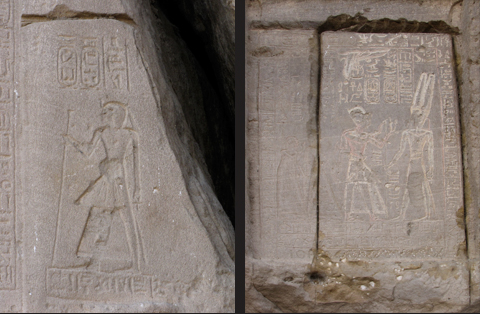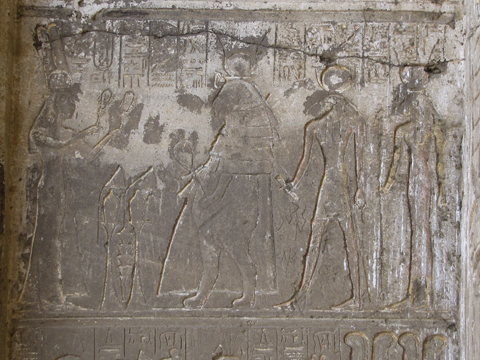Gebel Silsila
Gebel Silsila is the name given to a rocky gorge between Kom Ombo and Edfu where the River Nile narrows and high sandstone cliffs come right down to the water’s edge. There was probably a series of rapids here in ancient times, dangerous to navigate, which naturally formed a frontier between the regions of Elephantine (Aswan) and Edfu. In Pharaonic times the river here was known as Khennui, the ‘place of rowing’. On the West bank there is a tall column of rock which has been dubbed ‘The Capstan’ because of a local legend which claims there was once a chain (Silsila in Arabic) which ran from the East to the West Banks. Arthur Weigall in his ‘Antiquities of Egypt’ states that the name Silsileh, is a Roman corruption of the original Egyptian name for the town, Khol-Khol, meaning a barrier or frontier.

It is hardly surprising that by Dynasty XVIII, travellers had developed the custom of carving small shrines into the cliffs here, dedicating them to a variety of Nile gods and to the river itself. Smaller shrines were cut by Tuthmose I, Hatshepsut and Tuthmose III, before Horemheb constructed his rock-cut temple here, then many of the Dynasty XIX or later kings left their mark in some way. Gebel Silsila became an important cult centre and each year at the beginning of the season of inundation offerings and sacrifices were made to the gods associated with the Nile to ensure the country’s wellbeing for the coming year.
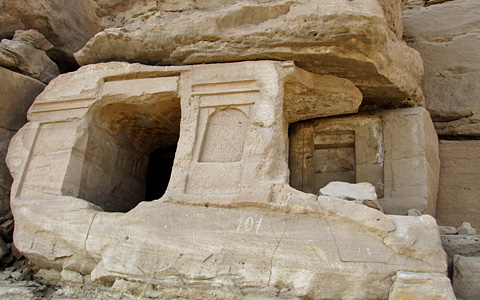
On both banks of the Nile the massive quarries produced the sandstone needed for the prolific construction of monuments during Dynasty XVIII, at first in small quantities and as the skills of the workmen grew, the stone was more extensively quarried to build great monuments such as the colonnade of Amenhotep III at Luxor, the Karnak Temple of Amenhotep IV, the Ramesseum and Medinet Habu, to name but a few. By Ptolemaic times most of the Upper Egyptian temples contained monuments built from Gebel Silsila sandstone. Because of the sanctity of the site, the sandstone was considered to have an extra holiness.
Gebel Silsila West
The steep sandstone cliffs of the West Bank are cluttered with grafitti, shrines and stelae, including 33 rock chapels. Dynasty XVIII saw the construction of shrines by Tuthmose I, Hatshepsut, Tuthmose III and Horemheb and in Dynasty XIX, Rameses II, Merenptah, Siptah, Seti II, Rameses III and Rameses V had elaborate stelae carved on the rocks. Seti I left an inscribed Hymn to the Nile and inaugurated two festivals, which were continued to be endowed by Rameses II and Merenptah.

The most prominent deity depicted here appears to be Sobek the crocodile god, ‘Lord of Khennui’, who with Haroeris (Horus the Elder) is one of the twin gods of Kom Ombo. Hapi as god of the Nile also received a large share of offerings. The site’s proximity to Aswan meant that the Triad of Elephantine, Khnum, Satet and Anuket were worshipped here. Tauret the hippopotamus goddess is also featured at Gebel Silsila, especially in the Speos of Horemheb.
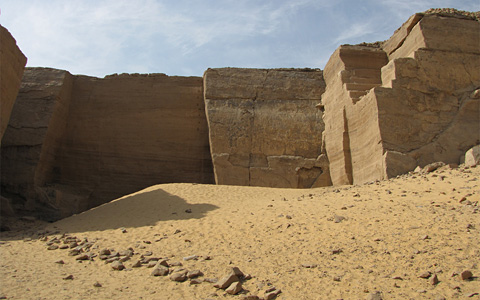
Towards the southern end of the west bank of the river, three shrines were constructed by Merenptah, Rameses II and Seti I (from north to south), with a quay in front of them, but Seti’s shrine and the quay were destroyed by an earthquake. These shrines are now most easily accessible by boat. To the north, sheer quarried rock faces that look like sliced blocks of cheese, contain mason’s marks, artisans’ drawings and other evidence of ancient workings. A rock-cut staircase leads hopefully up one side of these cliffs, only to vanish at the top leaving you almost stranded. There is, however a rough rocky path that leads past ‘The Capstan’ and on to the royal shrines.
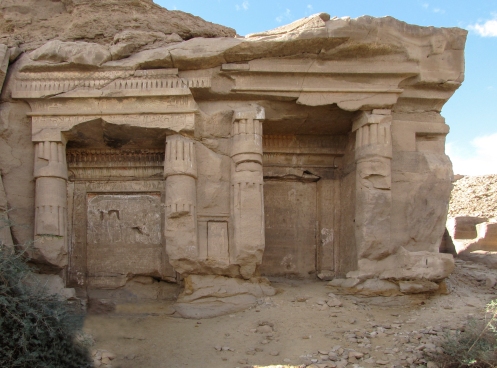
The first monument here is a large rock stele at right-angles to the river, built by Rameses III and dated to Year VI of his reign. The first of the royal shines was built in the first year of Merenptah and like the other two was recessed deep into the rock behind two columns and a cornice. The king is seen worshipping a variety of gods and the inscription depicts a Hymn to the Nile. To the south is a small stele of Merenptah on which the king offers a figure of Ma’at to Amun-re. Behind him stands the Vizier Panahesy and another official. Sadly in June 2012, the lower part of this stele has been badly damaged by thieves attempting to remove it from the rock.
The second shrine belongs to the early reign of Rameses II and also shows the king worshipping several deities. Queen Nefertari is seen before a figure of the hippopotamus goddess Tauret who is dressed in a very unusual robe. To the south of the Rameses shrine is another small stele to Merenptah on which the King is joined by the High Priest of Amun, Roy. A small figure of King Amenhotep I stands beside this stele.
The third shrine and the earliest in the group was mostly destroyed by an earthquake. It was built for Seti I and seems to have been in a similar style to the other two royal shrines.
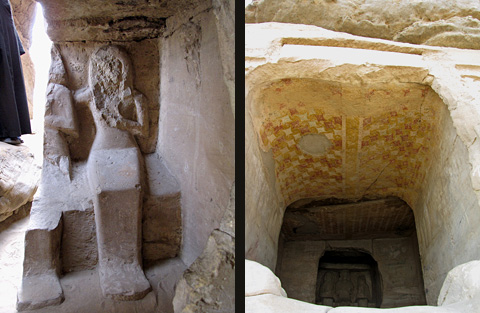
Further north, the visitor can see the majority of rock-shrines, some with elaborate chapels containing statues of the owners and with beautiful decorated ceilings. Many of these shrines have been damaged by quarrying or earthquakes and are now open to the elements, but they can be seen from the wide path that runs along the river bank. The shrines belong to high officials, priests, royal scribes and nobles of the time. There is also a Dynasty XVIII tomb belonging to Sennefer, a libation priest from Thebes who was buried here with his wife Hatshepsut. The tomb is now open to the sky, and the remains of five seated statues as well as hieroglyphic inscriptions can be seen, close to the water’s edge.
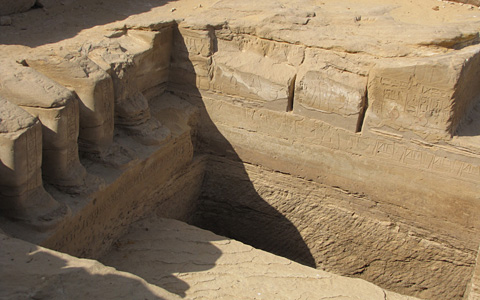
At the northern extent of the quarries there are three large rock-stelae carved for Rameses V, Shoshenq I and Rameses III (from north to south). The stele of Rameses V, one of his largest known monuments, contains an inscription dedicated to Amun-Re, Mut, Khons and Sobek-Re of Khennui. Shoshenq’s stela tells of how the king quarried here for his building works at Karnak in year 21 of his reign. On the stele of Rameses III, the king is seen offering a statue of ma’at to Amun-Re, Mut and Khons.
The Speos of Horemheb
Horemheb was the last king of Dynasty XVIII and he carved a much larger rock-chapel, or speos, out of the hillside at the northern end of the site. The chapel was dedicated to Amun-Re as well as other deities that were connected to the River Nile.
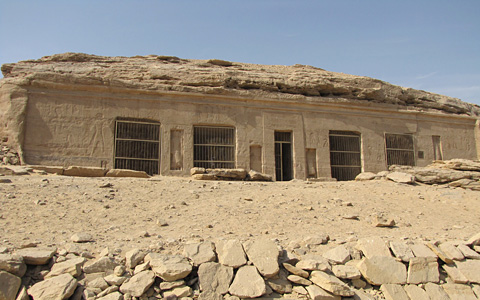
The monument consists of a façade of five doorways separated by pillars of differing widths, behind which is a long transverse hall with vaulted roof and a smaller oblong chamber, the sanctuary, to the rear. All the walls are covered in reliefs and inscriptions, in some places quite damaged, but in others there are some very fine high quality reliefs. Horemheb himself never finished the speos, and the decoration was later completed by subsequent kings and nobles who carved their own stelae and inscriptions on the walls.

The deities depicted on the walls, besides Amun-re, are Sobek in the form of a crocodile, the ram-headed god Khnum of the First Cataract, Satet of Elephantine, Anuket, goddess of Sehel, Tauret as a hippopotamus and Hapi, god of the Nile. As well as those of Horemheb, cartouches of Rameses II, Merenptah, Amenemesse, Seti II, Siptah and Rameses III appear in the reliefs.

On the southern end wall, the benevolent goddess Tauret is seen in rare human form, suckling the young King Horemheb. Behind her is a damaged figure of Khnum and to her left, Amun-Re and Sobek of Kennui.

The western wall depicts one of the most noted reliefs of Horemheb, the king’s ‘Triumphal Procession’ after his victory in Nubia. Horemheb is shown seated on a portable lion-chair which is carried by twelve soldiers wearing plumes of feathers. At the front and back of the king are his fan-bearers, protecting Pharaoh from the sun. His entourage include rows of priests, soldiers, a trumpeter and several groups of captured prisoners, all depicted in a very natural style, almost echoing some of the Amarna Period reliefs. The inscription above the king extols his victory over the people of Kush.
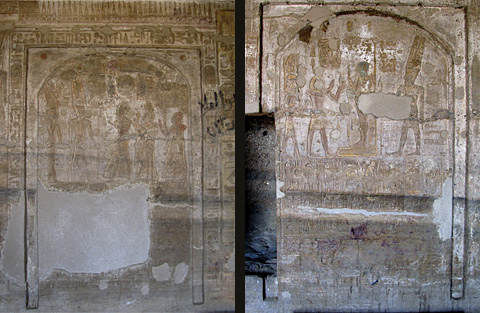
Another important relief here depicts a list of four Heb-sed festivals of Rameses II in the 30th, 34th, 37th and 40th years of his reign, which were supervised by his eldest son, Prince Khaemwaset. This prince, renowned for his priestly wisdom as well as his restoration works, appears in several places in the chapel, along with his mother Queen Asetnefert and Princess Bentanta, as well as other favoured officials of the reign. Khaemwaset presumably died before the 42nd jubilee of Rameses II was celebrated at Gebel Silsila as this was conducted by the Vizier Khay, who also has a presence in the speos. Merenptah, the son and successor of Rameses II is depicted on a stele with his wife Asetnefert and his Vizier Panehesy adoring Amun-Re and Mut.
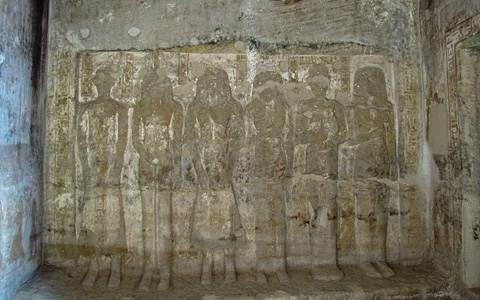
On the northern end wall there is a niche with six figures cut in high relief, depicting (from west to east) the Vizier Panehesy, the goddess Ma’at, a male relation Amennakht, a female relation ‘Songstress of Hathor’, the god Ptah and finally Ra’y, a female relation with the title ‘Songstress of Re’. This is a rare relief where a private family is seen in the presence of the gods. Many other stelae and reliefs line the walls of the hall, giving the names of Dynasty XIX kings and their officials.

The sanctuary to the rear of the vaulted hall contains seven very damaged figures which are said to depict Sobek, Tauret, Mut, Amen-Re, Khons, Horemheb and Thoth. The side walls show a wide variety of gods and demi-gods, while the walls inside the doorway have reliefs of the Elephantine Triad, Khnum, Satet and Anuket as well as Osiris and the scorpion goddess Selkhet. Tauret presides over a symbolical representation of the union of Upper and Lower Egypt.
Gebel Silsila East
The east bank of the Nile contains the more spectacular quarries of Gebel Silsila which were most exploited during the New Kingdom, particularly under Rameses II, who employed three thousand workers to cut stone for the construction of the Ramesseum on the west bank at Thebes. Many shrines and stelae were cut into the rock here too and the names of kings who worked the quarries are attested by their officials who gave detailed accounts of their work.
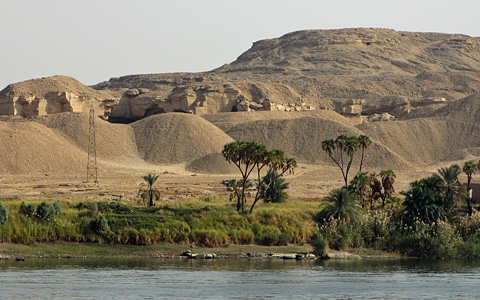
The inscription on a large stele of Amenhotep III records the transport of stone for the construction of a temple of Ptah. His son Amenhotep IV, who later became Akhenaten, also has a stele here on which he worships Amun and records that he quarried stone for an obelisk to be erected in his Temple of the Sun at Karnak. Stelae of Seti I and King Apries can also be seen. Among the grottos and shelves of quarried sandstone, several unfinished sphinxes remain, of both the ram and human-headed variety, forever rooted to the bedrock. At the foot of the hills, there are a number of small rock-cut tombs. Rameses II built a temple at Gebel Silsila East, but this has now been destroyed.

Unfortunately, the east bank quarries are now officially closed to visitors without special permission.
How to get there
Gebel Silsila West can be reached by road from Edfu, following the river south for about 40km. A series of villages amble through green agricultural fields gradually giving way to desert. After the last small village, the track climbs steeply into the sandstone quarries. Alternately, it may be possible to hire a felucca from Edfu or Aswan which can sail on the river and moor at the bank for a visit to the monuments. A modern but rather neglected visitor centre has been built at Gebel Silsila West and tickets are sold for 25 LE. A guard will escort visitors around the monuments.

